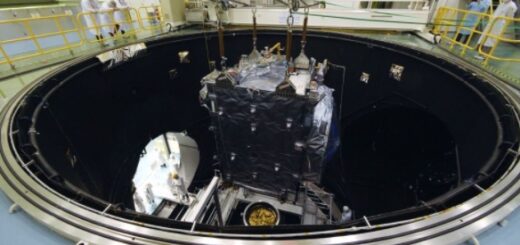Astronomers spot the fastest spinning magnetar ever seen

Far-off in the Milky Way galaxy, 21,000 light-years from Earth, astronomers have spotted the fastest-spinning magnetar (and possibly youngest, too) ever seen. And that’s just the start of what makes this star strange.
Magnetars are a unique type of neutron stars, which are the collapsed cores of supergiant stars that died in supernova events. What sets magnetars apart from other neutron stars is that they possess extremely powerful magnetic fields — he most powerful ones in the known universe, in fact. They can also explode without warning and are fairly difficult to spot. In fact, before this object was discovered, there were only 30 known magnetars, compared to the thousands (approximately 3,000) known neutron stars.
Now, scientists studying the skies with NASA’s Chandra X-ray Observatory — a space telescope that looks out at black holes, supernovas and more — think that a newly discovered magnetar known as J1818.0-1607 could be the fastest-spinning and possibly also the youngest magnetar known, according to a statement. They also found a myriad of other odd things that make this object truly unique.
Astronomers first spotted this magnetar on March 12, 2020 with NASA’s Neil Gehrels Swift Telescope. Later on, Harsha Blumer, an astronomer at West Virginia University, and Samar Safi-Harb, a physics professor at the University of Manitoba in Canada, observed the magnetar using Chandra, and they noticed a couple of peculiar things that made the magnetar stand out.
One of the first things that seemed intriguing about this particular object was how young it appeared. The team estimated that the magnetar is about 500 years old, which, if true, would make it the youngest discovered yet. They determined the object’s age by measuring how quickly the rotation rate of the magnetar is slowing down (it spins slower over time) while assuming that the object started out spinning much faster.
The second thing that really stood out to the team was just how fast the object was spinning, as it seemed to be rotating once fully every 1.4 seconds (which is really, really fast).
Other astronomers have taken a look at J1818.0-1607 as well, observing the magnetar using radio telescopes like the National Science Foundation’s Karl Jansky Very Large Array (VLA) and have found that it’s emitting radio waves, a quality it shares with objects known as “rotation powered pulsars.” These are a type of neutron star that emits radiation that we on Earth detect as “pulses” of radio wave emissions.
In this up-close composite image, you can see magnetar J1818.0-1607 in purple. Scientists think that this object could be the fastest-spinning and possibly even youngest magnetar ever found.
In this up-close composite image, you can see magnetar J1818.0-1607 in purple. Scientists think that this object could be the fastest-spinning and possibly even youngest magnetar ever found. (Image credit: X-ray: NASA/CXC/Univ. of West Virginia/H. Blumer; Infrared (Spitzer and Wise): NASA/JPL-CalTech/Spitzer)
Blumer and Safi-Harb also found that the magnetar isn’t converting spinning energy from its rotations into X-ray emissions as efficiently as expected for a magnetar. In fact, the object is converting this energy at a rate most common with rotation-powered pulsars, another interesting commonality between the two objects.
The last odd thing that the pair of researchers found about this young, fast star was that, while most magnetars around this age would have left behind a debris field of material leftover from the supernova that created the object, the researchers only found possible evidence of a supernova remnant with J1818.0-1607, and this debris was pretty far from the object.
By their estimations, in order for the debris field to have traveled that far away from the magnetar, the object would’ve needed to have traveled at speeds faster than ever seen with a neutron star.
This work was accepted for publication in the Astrophysical Journal Letters.



 Creators of mankind
Creators of mankind Description of “Tall white aliens”
Description of “Tall white aliens” Where they came from?
Where they came from? About hostile civilizations
About hostile civilizations The war for the Earth
The war for the Earth “Tall white aliens” about eternal life
“Tall white aliens” about eternal life Video: “Nordic aliens”
Video: “Nordic aliens” Aliens
Aliens Alien encounters
Alien encounters The aliens base
The aliens base UFO
UFO Technology UFO
Technology UFO Underground civilization
Underground civilization Ancient alien artifacts
Ancient alien artifacts Military and UFO
Military and UFO Mysteries and hypotheses
Mysteries and hypotheses Scientific facts
Scientific facts


















